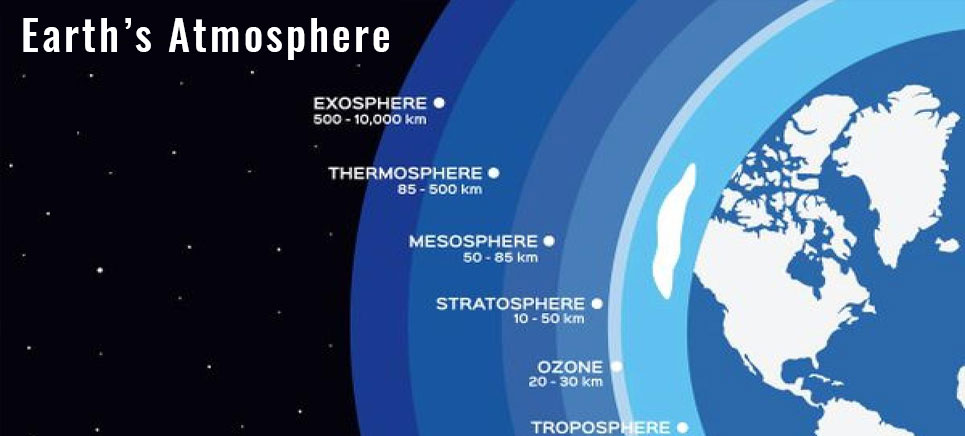The layers of gases surrounding a planet or other celestial bodies are termed as the atmosphere. Our planet earth has an atmosphere that contains 78% Nitrogen, 21% Oxygen, 0.04% Carbon Dioxide and traces of Hydrogen, Helium, Methane, Neon, Krypton as well as water vapor. The atmosphere helps the life on Earth by keeping the planet warm through insulation and this is why the atmosphere is called the blanket of Earth. It also prevents extreme temperatures between day and night. Atmosphere also protects us against the harmful ultraviolet radiation. It is certain that if there was no atmosphere there would not have been any life on Earth.
The Layers of Earth’s Atmosphere
Atmosphere of Earth comprises 5 layers – distinguished mainly on the basis of temperature. Moving upward from the earth’s surface, the atmosphere is composed of troposphere, stratosphere, mesosphere, thermosphere and exosphere.
1. Troposphere
The lowermost layer of the atmosphere is called the troposphere. The temperature in this layer gets colder with increasing altitude, by around 6.5 degrees centigrade per kilometer. This is the densest layer as it contains about 75% of the air in the atmosphere.
2. Stratosphere
The layer above the troposphere is the stratosphere which contains much of the ozone of the atmosphere. The ozone layer of the stratosphere protects us from harmful UV rays. Due to this absorption of UV rays, the temperature in this layer increases with altitude.

3. Mesosphere
The layer of atmosphere that lies above the stratosphere is called the mesosphere — aka the middle layer. The temperature in this region again starts decreasing with an increase in altitude. The minimum temperature in this layer can go up to -90% centigrade.
4. Thermosphere
This layer of very rare air is found above the mesosphere. This is the layer that absorbs high energy UV and X-rays from the sun. This is the reason temperature starts rising in this layer of the atmosphere. The maximum temperature can also go up to 1000 degrees centigrade in the thermosphere.
5. Exosphere
The atmosphere above 500 Km from the earth is called the exosphere. This layer mainly contains oxygen and hydrogen atoms but they are so rare that they hardly collide. There’s no clearly defined boundary between the exosphere and outer space.
Formation of Earth’s Atmosphere
The earth’s atmosphere in its present form has been formed over a long geological period and with a very complex process. When the earth was formed, some 4.6 billion years ago, from molten rocks and hot gases, it had no atmosphere at all. The atmosphere was gradually formed with the cooling of the earth’s surface. This formation of the atmosphere can be understood in three broad stages.
Stage 1
The initial atmosphere of the earth was formed mainly of hydrogen and helium. The earth as well as its atmosphere were very hot. Helium and hydrogen atoms have the property of moving fast, especially when hot. Due to this property, most of the hydrogen and helium particles escaped the earth’s gravitational pull and drifted into outer space.
Stage 2
There were lots of volcano eruptions during the formation of the earth’s surface. These volcanoes released steam (H2O), carbon dioxide (CO2) and ammonia (NH3). So, the atmosphere formed during this period contained these gases released from the volcanoes.
Stage 3
A massive quantity of carbon dioxide (CO2) in the atmosphere got dissolved in the enormous water body present on earth’s surface which we today know as oceans. Eventually, a simple form of bacteria developed that could survive on the energy from the sun and the CO2 in the water. These bacteria released oxygen as a waste product thus adding up oxygen in the atmosphere. The sunlight broke ammonia into molecules of hydrogen and nitrogen. Nitrogen remained in the atmosphere while the hydrogen escaped into outer space. All these processes eventually created an atmosphere that could support life on earth.
Use the citation below to add this article to your bibliography
"Earth’s Atmosphere: Layers, Composition and Formation." Dashamlav.com. Web. 22 October 2024. <https://dashamlav.com/earth-atmosphere-layers-composition-formation/>
Dashamlav.com, "Earth’s Atmosphere: Layers, Composition and Formation." Accessed 22 October 2024. https://dashamlav.com/earth-atmosphere-layers-composition-formation/
"Earth’s Atmosphere: Layers, Composition and Formation." (n.d.). Dashamlav.com. Retrieved 22 October 2024 from https://dashamlav.com/earth-atmosphere-layers-composition-formation/

Very informative